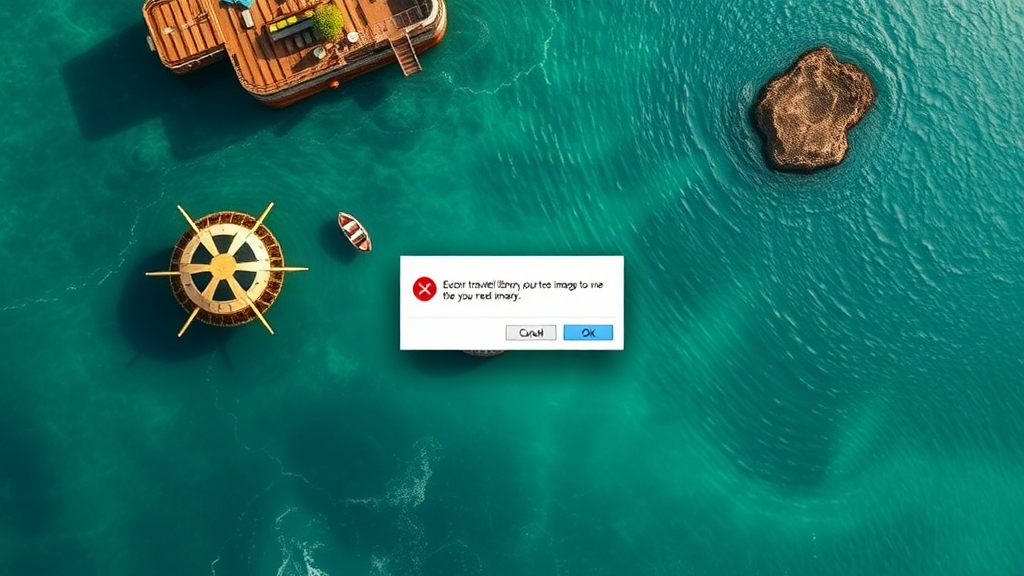Troubleshooting the “Export Traveling Library Does Not Bring Up Dialogue Box” Issue
Encountering the issue where the “Export Traveling Library does not bring up dialogue box” can be frustrating, especially when you need to manage your library data effectively. This problem typically arises in various software settings, often related to library systems or cataloging software. Here are some common causes and solutions to this issue.
Understanding the Issue
The main problem occurs when users try to export a traveling library, but the expected dialogue box fails to appear. This can prevent you from saving your data or making necessary adjustments. Understanding the reasons behind this issue is the first step toward resolving it.
Potential Causes
- Software Glitch: Software bugs or temporary glitches can lead to a failure in opening dialogue boxes.
- Incorrect Settings: Sometimes, user settings or configurations might interfere with the library export process.
- Operating System Issues: Compatibility issues between your library management software and the operating system can hinder functionality.
- Outdated Software: Using an outdated version of library software can cause various problems, including export glitches.
Troubleshooting Steps
If you encounter the problem where the export traveling library does not bring up the dialogue box, try the following troubleshooting steps:
1. Restart the Software
It may sound simple, but restarting the software often resolves temporary glitches. Close your library management application completely and then reopen it. Check if the dialogue box appears during the export process.
2. Check for Updates
Ensure you are using the latest version of your library management software. Visit the official website of the software provider to check for any available updates. Installing these updates can fix known bugs related to the export feature. Many library software providers also share updates on their update page.
3. Review User Settings
Double-check your settings within the software. Sometimes, user preferences or permissions can prevent dialogues from appearing. Look for any export-related settings to ensure they are configured correctly.
4. Look for Error Messages
If the software generates any error messages during the export process, take note of them. These messages can provide clues regarding what went wrong. Search the specific error messages online for community solutions or supplier assistance.
Advanced Solutions
If the basic troubleshooting steps do not resolve the issue, you may need to explore more advanced solutions. Here are some additional steps to consider:
1. Reinstall the Software
Uninstalling and reinstalling your library management software can often fix persistent bugs. Before you do this, back up your data to avoid losing important information. Follow the reinstallation guide provided by the software vendor on their website.
2. Check Compatibility with Operating System
Ensure that your software is compatible with your current operating system. If a compatibility issue is suspected, consult the software documentation or the support team for advice on how to address it.
3. Contact Support
If you have exhausted all other options and still face the same problem, reaching out to customer support is a wise choice. Provide them with detailed information about the issue and the troubleshooting steps you have already taken. You can find support contact information on the software’s website, such as Libapps Support.
Best Practices
To avoid facing this issue in the future, here are some best practices:
- Regularly update your software to ensure you have the latest features and fixes.
- Document any settings or configurations you change, so you can revert if something goes wrong.
- Backup your library data frequently to prevent loss during troubleshooting.
Troubleshooting the issue of the export traveling library not bringing up a dialogue box can seem daunting. However, by following these steps, you can swiftly address the problem and continue managing your library effectively. Remember, maintaining an updated and well-functioning software environment is essential for a smooth experience.
Understanding the Benefits of Using a Traveling Library in Project Management
Utilizing a traveling library in project management can significantly enhance the efficiency and collaboration of teams across various projects. This innovative approach to resource management provides project managers with the ability to share data, documents, and essential tools with team members, regardless of their geographical locations.
When you think about the concept of a traveling library, imagine having a dedicated resource hub that can move with the project team. This system allows for seamless access to necessary materials and knowledge, promoting a culture of continuous learning and collaboration.
Benefits of a Traveling Library in Project Management
- Improved Access to Information: A traveling library makes it easy for team members to access crucial documents on-the-go. Instead of searching through endless email chains or physical paperwork, employees can find what they need right in the library.
- Enhanced Collaboration: Use of a traveling library promotes teamwork. When team members can share and contribute content to the library, everyone benefits from different perspectives and insights.
- Flexibility: Project managers can customize their libraries based on project needs and team feedback. The library can evolve with the project, adapting its resources as requirements change.
- Time-Saving: With everything organized in one place, team members spend less time looking for information. This efficiency translates into more time dedicated to productive tasks that drive the project forward.
- Knowledge Management: Documenting everything in a traveling library means institutional knowledge is preserved. This is vital when team members leave or transition, ensuring that valuable insights and resources are not lost.
How a Traveling Library Enhances Project Management Strategies
Integrating a traveling library into project management processes presents an array of advanced strategies for successful project execution. Here’s how:
Centralized Repository
A traveling library acts as a centralized repository where all project-related information is housed. This way, anyone involved can contribute, access, and update resources as needed. You can categorize materials based on phases of the project or types of resources for better organization.
Real-Time Updates
Unlike static libraries, a traveling library can feature real-time updates. This means whenever a critical change occurs, all team members can instantly access the most current information. Whether it’s newly refined objectives or updated timelines, having real-time information at your fingertips is crucial for effective project management.
Encouraging Professional Development
Utilizing a traveling library also encourages professional development among team members. It can include training materials, guides, and tutorials. When you allow your team to seek growth opportunities from the resources within the library, they become more engaged and motivated to contribute effectively to the project.
Implementing a Traveling Library: Key Steps
For organizations considering a traveling library for their project management needs, it’s vital to follow these steps:
- Identify the needs of your team and the project’s requirements.
- Choose a suitable platform or tool that can function as a traveling library.
- Set up categories and organize resources efficiently for easy accessibility.
- Encourage team members to actively contribute to the library.
- Regularly update the library to ensure ongoing relevance of the materials.
Tools and Resources to Consider
There are various tools that can efficiently support a traveling library. Below are some popular options:
| Tool | Feature |
|---|---|
| Google Drive | Cloud storage for documents with collaborative features. |
| Trello | Project management tool with boards for organized tasks and resources. |
| Slack | Communication platform that allows sharing documents in real-time. |
Utilizing these platforms ensures a structured approach to managing your traveling library. Each tool comes with features tailored to enhance collaboration and resource accessibility.
A traveling library into your project management strategy not only streamlines operations but also empowers your team members, fostering an environment where creativity and innovation can thrive. This dynamic resource hub is not just a trend; it’s a crucial step toward enhancing collaboration in contemporary project management.
Best Practices for Managing Library Exports in Software Development
Managing library exports effectively is crucial in software development. When exporting libraries, adhering to best practices ensures smoother integration, minimizes errors, and improves collaboration among teams. Below are some key strategies to help you manage library exports efficiently.
Understanding Library Exports
Exporting libraries involves saving and sharing reusable code components across various applications. This can enhance consistency and reduce overhead for developers. You must plan your approach carefully to avoid common pitfalls.
1. Use Version Control Systems
Implementing version control systems (VCS) like Git can significantly improve how you manage library exports. A VCS provides a history of changes made, enabling teams to track updates and control the versions being used in different projects.
- Consistency: Ensures that all team members work with the same version of a library.
- Collaboration: Facilitates multiple developers updating the library without conflicts.
- Reversion: Allows teams to revert to earlier versions if issues arise.
2. Establish Clear Naming Conventions
Adopting a clear and consistent naming convention for your libraries can reduce confusion and errors. When libraries are clearly named, developers can quickly identify their purpose and scope, leading to better integration.
| Convention | Description |
|---|---|
| Prefix | Use a common prefix to group related libraries. |
| Suffix | Add a suffix that denotes the library version (e.g., v1.0). |
3. Maintain Documentation
Providing comprehensive documentation is vital for seamless integration and usage of exported libraries. Well-documented libraries improve developer experience and reduce the risk of mistakes.
- Code comments: Regularly comment on your code to explain functionality.
- Readme files: Include straightforward readme files with examples on how to utilize the libraries.
- Change logs: Maintain change logs to inform users about what has changed in each version. This is essential for understanding the impact of updates.
4. Automate Testing and Deployment
Implementing automated testing and deployment can significantly enhance the reliability of library exports. Automated testing will help detect bugs and inconsistencies before any library is exported. Continuous integration/continuous deployment (CI/CD) tools can streamline the process.
- Regression tests: Ensure new changes do not break existing functionality.
- Build pipelines: Automate the process of building and deploying library updates.
- Code quality checks: Use tools to assess the quality of the code before exporting.
5. Define Export Protocols
Setting clear protocols for how libraries should be exported is crucial. This includes determining the format of exports, the platforms they should support, and the security measures that need to be in place.
| Protocol Type | Examples |
|---|---|
| Files format | npm packages, JAR files, ZIP |
| Platforms supported | Windows, Linux, macOS |
| Security measures | Code signing, dependency checks |
6. Regular Audits and Updates
Scheduling regular audits of your library exports can help you identify outdated libraries or vulnerabilities. Keeping your libraries up-to-date is essential for ensuring security and performance.
- Dependency management: Utilize tools that help manage library dependencies, such as npm’s
npm auditfeature. - Scheduled reviews: Establish a regular schedule (e.g., monthly) to review and update libraries.
7. Engage with the Developer Community
Joining online communities or forums can help developers share insights regarding library exports. Networking with other software developers provides opportunities to learn from their experiences.
Consider participating in platforms such as:
Managing library exports in software development requires a proactive and systematic approach. By implementing version control, maintaining clear naming conventions, providing thorough documentation, automating testing and deployment, defining export protocols, conducting regular audits, and engaging with the developer community, you can ensure smooth library exports and improve overall project quality.
Common Errors Encountered When Exporting Libraries and How to Fix Them
When working with libraries in software applications, you might encounter a range of errors during the export process. These issues can range from missing files to improper configurations. Here’s a look at some common errors and their solutions to help you smoothly navigate through the exporting process.
File Path Issues
One of the most frequent errors involves the file path. If your library’s export settings point to an incorrect or non-existent file location, an error will occur.
- Solution: Check the file path specified in the export settings. Ensure it accurately points to a valid directory.
- Tip: Use absolute paths instead of relative paths to avoid confusion.
Permission Restrictions
Another common issue is permissions on your operating system or network. When your software does not have adequate permissions to access certain directories or files, it can lead to export failures.
- Solution: Ensure that the application has the necessary permissions to read/write to the intended export location.
- Tip: For Windows users, you may need to run the application as an administrator.
Corrupted Library Files
Corruption in the library itself can also hinder your ability to export effectively. If you attempt to export a library with corrupted files, you may receive an error message.
- Solution: Validate and repair corrupted files before exporting. This can often be done through built-in repair tools within your software.
- Tip: Regularly back up your libraries to minimize the risk of permanent data loss.
Settings Configuration
Inadequate or incorrect settings can cause export failures as well. For instance, improper configurations in the library settings might prevent a dialog box from appearing during an export attempt.
- Solution: Review your export configurations to ensure they are set correctly. Pay special attention to file formats and specific export options.
- Tip: Refer to documentation from the library’s official site for settings that are known to work.
Dialog Box Fails to Appear
Sometimes, users experience an issue where the export dialog box does not show up at all. This can be frustrating and may lead to a temporary halt in your workflow.
- Solution: Restart the application or check for updates. Sometimes, bugs in the current version might be responsible for such glitches.
- Tip: Ensure that your software is compatible with the current operating system. Visit the official site for compatibility details. (https://www.example-software.com)
Insufficient Storage Space
Exporting libraries can consume a significant amount of disk space. If your disk is almost full, you might face an error while trying to export.
- Solution: Check your available storage space and free up required space before attempting another export.
- Tip: Use external storage devices for large exports to avoid running into space issues on your main drives.
Incompatibility With Previous Versions
When libraries are updated, sometimes they become incompatible with previous versions of software. This can lead to problems when exporting.
- Solution: Ensure that both your library and your software are updated to their latest versions for optimal compatibility.
- Tip: In some cases, consider downgrading to a previous version that worked well for you.
Network Issues
If you are exporting libraries over a network, network interruptions can cause export failures. This includes situations like poor connection or timeouts.
- Solution: If possible, switch to a wired connection for a more stable export experience. Test the network speed and performance prior to the export.
- Tip: Performing a speed test with a tool like [Speedtest](https://www.speedtest.net) can help diagnose connection issues.
Use of Specialized Export Tools
In certain scenarios, employing specialized tools that manage library exports can greatly enhance reliability and ease. Such tools often come equipped with troubleshooting features to help you resolve issues promptly.
- Solution: Explore tools designed specifically for your software environment ([Example Link](https://www.librarytools.com) – opens in new window).
- Tip: Evaluate user reviews to find tools with a strong track record of resolving export issues.
By being aware of these common errors and their corresponding fixes, you can significantly improve your library exporting experience. Check your configurations, permissions, and space regularly to prevent problems before they occur.
Enhancing User Experience When Exporting Libraries: Tips and Tools
When it comes to enhancing user experience during the export of libraries, understanding the common pitfalls can make all the difference. Many users find themselves frustrated when the export traveling library does not bring up a dialogue box. This can create confusion and delay, prompting the need for effective solutions and preventative measures.
You might be wondering why exporting libraries is sometimes a problem. When you see a message indicating an export failure or no response at all from the software, here are some straightforward tips to help you troubleshoot.
Common Reasons for Issues
- Software Bugs: Sometimes, the application itself may have bugs that can lead to failures in dialogs appearing. Developers often release patches to fix these.
- Settings Misconfiguration: Check the settings within your library management system. Unintended changes may prevent the dialogue box from functioning correctly.
- Corrupted Files: If the library files have been corrupted or are incompatible with the software, this might cause export issues.
- System Compatibility: Ensure your operating system meets the requirements of the software that manages your library.
Troubleshooting Steps
If you find yourself in a situation where your export traveling library does not bring up a dialogue box, follow these troubleshooting steps:
- Restart the Application: Close and reopen the software. This may resolve temporary glitches.
- Update the Software: Check for updates from your library management system.
- Review User Permissions: Ensure that you have the necessary permissions to perform exports.
- Check for External Interference: Sometimes, antivirus software can interfere with the normal operation of applications. Temporarily disable it to check if that’s the issue.
Tools to Enhance Your Experience
Utilizing the right tools can significantly enhance your library export experience. Here are a few recommended tools:
- Export Wizard: A user-friendly tool specifically designed to assist with exporting libraries. This tool guides users through the process, making it seamless.
- Data Backup Solutions: Platforms like Backblaze (open in new window) can help you ensure your library data is safely backed up before you attempt an export.
- File Repair Tools: Use tools like Stellar Repair (open in new window) if you suspect your library files are corrupted.
User Tips for a Smooth Export Process
- Regular Maintenance: Schedule regular checks of your libraries to identify any issues before you need to export.
- Test Exports: Before a large batch export, conduct test runs with smaller libraries to ensure everything works as intended.
- Documentation: Keep thorough documentation of settings and operations. This can help you quickly troubleshoot if issues arise in future exports.
Additional Considerations
While you work on enhancing user experience, consider these factors as they can also impact the export process:
| Factor | Impact on Export |
|---|---|
| User interface design | Intuitive interfaces reduce errors |
| System performance | Faster systems result in quicker exports |
| Training & Support | Knowledgeable users can troubleshoot effectively |
Resources for Further Assistance
If you continue to struggle with exporting libraries, don’t hesitate to seek help. User forums, FAQ sections, and customer support can provide additional insights. Websites like Library Technology Reports (open in new window) offer a wealth of information on library systems and troubleshooting.
By following these tips and utilizing the right tools, you can greatly improve your experience when exporting libraries. Remember, the key is to stay proactive and informed about best practices in library management. Your ability to efficiently export libraries not only saves time but also enhances your overall workflow. So, equip yourself with knowledge and resources to turn any export issue into a manageable situation.
Conclusion
Addressing the issue of “Export Traveling Library Does Not Bring Up Dialogue Box” is crucial for anyone involved in project management or software development. Troubleshooting this problem enhances not only your individual workflow but also the overall efficiency of your team’s output. Understanding the advantages of using a traveling library can help streamline processes, making project management smoother and more effective.
Implementing best practices when managing library exports ensures that your projects stay organized and minimizes the chance of errors. Many users face common hurdles during the export process, but knowing how to identify and resolve these issues can dramatically improve your experience. By incorporating straightforward solutions, you can turn potential frustrations into quick fixes, thereby saving valuable time and energy.
Furthermore, enhancing user experience when exporting libraries is vital for maintaining productivity. Whether it’s utilizing specific tools or adhering to recommended strategies, the right approach can make a significant difference. A smoother export process not only keeps you focused on your deliverables but also fosters a collaborative environment within your team.
Ultimately, addressing the “Export Traveling Library Does Not Bring Up Dialogue Box” concern is just one piece of the puzzle. By combining effective troubleshooting, an understanding of the traveling library’s benefits, and best practices, you equip yourself and your colleagues for success in your projects. Consistently refining these processes will not only alleviate immediate challenges but also lay a foundation for a more productive and satisfying work experience in the long run.















Leave a Reply